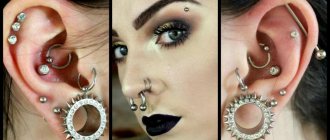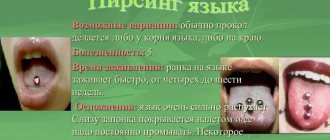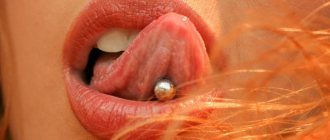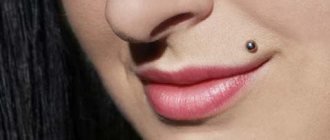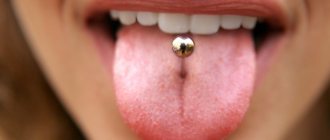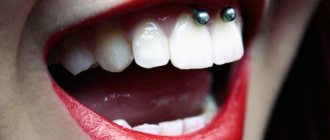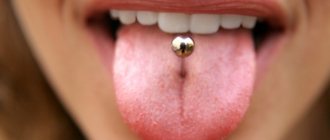Behind the tongue piercing
In order for the piercing to heal well, you need to know how to care for your tongue piercing. Caring for a tongue piercing includes constant treatment of the oral cavity - Lakalut, Asepta or President rinses ; you need to rinse your mouth 4-5 times a day and after each meal and drink. Swelling after tongue piercing lasts at least 4-5 days, so during this time you will have to refrain from active conversations, hard, spicy and salty foods . If you notice that plaque has appeared after your tongue piercing, you should not try to remove it, as you will injure the piercing. After 2-3 weeks, you can change the barbell to a shorter one (downsize).
Why complications arise
The reasons for an unsuccessful puncture, depending on who provoked the complications, can be divided into two groups:
- Complications due to the fault of the master. Masters who work at home without the appropriate certificates and permits often make the procedure unsafe: they do not maintain sterility, do not undergo medical examinations, and pierce incorrectly. As a result, an infection enters the wound, and the instrument damages nerves and blood vessels.
- Complications caused by the client. Often clients are not ready for a long recovery period and do not follow the specialist’s recommendations. The wound requires careful, long-term care over several months, and if the wound is not treated or injured, this leads to infection.
The meaning of piercing
Piercing is a form of modification of any part of the body with soft skin tissue in order to insert jewelry there. Thus, the individual wants to emphasize her beauty and receive aesthetic pleasure. They use such decorations as labrets, rods, tunnels, studs and rings, but that’s not all! The most common facial piercings are eyebrow, lip, nose and tongue piercings. Piercings are also done on the navel and private parts of the body. The very concept of “piercing” can imply both the piercing process and the hole itself. Below are photos of tongue piercings and other types of punctures.
Dissolve ice or apply a cold compress / Cold compress
Cold compresses reduce pain and swelling. Numbness may be preferable to warm compresses, especially if you are experiencing severe pain.
Ice
You can suck on ice cubes for a few minutes to relieve symptoms. Repeat as many times as you want for body and face.
Regular compress
If ice cubes are not your thing, you can use a bag of frozen vegetables or soft ice to find relief.
To use a cold compress:
- Wrap the compress in a thin or strong paper towel.
- Gently apply to affected area for up to five minutes at a time.
- Repeat twice a day.
- Apply a warm compress | Warm compress
A warm compress can also minimize overall swelling and irritation.
You may not want to use a warm compress if you are already experiencing uncomfortably warm temperatures at the piercing site. In this case, start with a cold compress and progress to a warm compress if necessary.
Regular compress
You can make your own warm compress by placing a damp towel or other cloth-based item in the microwave for 30 seconds at a time.
Some store-bought compresses contain herbs or grains of rice, which help retain heat and apply gentle pressure. Beauty salon tattoo body and face enlarge individual parts.
You can make these changes to your homemade compress as well. Just make sure the fabric can be sealed or folded so that none of the added ingredients fall out.
To use a warm compress:
- Place a damp cloth, sock, or other homemade compress in the microwave for 30 seconds. Repeat until it is comfortably warm to the touch.
- If you have a heat compress, microwave or over-the-counter heat as directed on the product package.
- Apply the compress to the affected area (tattoo) for up to 10 minutes, up to two times a day.
Chamomile compress
Chamomile as a source has antioxidant and anti-inflammatory properties. A warm chamomile compress can speed up the healing process.
First, do a patch test to make sure you are not allergic to chamomile. Do it:
- Steep a chamomile tea bag in warm water for two to three minutes.
- Place the tea bag on the inside of your elbow.
- Leave on for three minutes and then remove. Let skin dry without rinsing.
- Wait 24 hours. If you do not experience redness or other signs of irritation, it is safe to apply a chamomile compress to the piercing.
To use a chamomile compress:
- Immerse two chamomile tea bags in boiled water for five minutes.
- Remove the tea bags and let them cool for about 30 seconds. The bags should be warm to the touch.
- Wrap each tea bag in a cloth or paper towel. This will help prevent the fibers from getting caught on your jewelry.
- Place a tea bag on each side of the hole for 10 minutes.
- Refresh tea bags with warm water if necessary.
- After 10 minutes, rinse the affected area with warm water and pat dry gently with a clean paper towel.
- Repeat this process daily.
- Avoid over-the-counter antibiotics and creams.
Over-the-counter antibiotics have long been used to treat infections. However, they are useless - and may even be dangerous - for body and facial piercings at a beauty salon.
Topical creams and ointments can trap bacteria inside the piercing and make the situation worse. Additionally, they are not intended for use in the mouth.
Oral cleansers containing hydrogen peroxide, alcohol and other antibacterial ingredients. They can also damage healthy skin cells and slow down the healing process.
You'd better stick to the cleansing and compress routine. Contact your piercer if you don't notice improvement within a day or two. Tongue piercing beauty salon tattoos to enlarge individual parts of the body and face.
How long does a tongue piercing take to heal?
The tongue can heal completely within ten to fourteen days after surgery. During the healing of the tongue, it is necessary to rinse your mouth with a special solution prescribed by a specialist. If the color of the patient's tongue changes and becomes brown or green, it is recommended to reduce the frequency of rinsing. After the procedure, the next day the tongue will begin to swell and increase in size and become more sensitive.
On days two to five, the tongue will become most swollen. At this time it will be very uncomfortable and difficult to speak and control your tongue. You will feel pain and discomfort, burning and tingling. The patient will be able to eat only foods prepared in a blender, pureed food and soft boiled vegetables and fruits. The patient will be able to see and feel the white liquid from the wound. These are dead blood cells, which are normal after this procedure. On the eighth or tenth day, you can replace the long barbell with a short one.
Treatment with medical and folk remedies
If the root cause when the tongue begins to hurt is identified as stomatitis, then, as a rule, the specialist prescribes a cycle of antibiotics and treatment of the oral cavity with antiseptic drugs - Miramistin or Chlorhexidine.
If the stumbling block is a disease of the endocrine system, then hormonal treatment is prescribed; as a rule, the problem is determined by diabetes. In a situation where ailments unrelated to dentistry are identified, only one or several qualified specialists can prescribe drug treatment. Traditional methods of treatment can be used if the source of pain does not have serious reasons.
Then, to stop your tongue from hurting, you can rinse with a salt or soda solution, and also hold the oil from sea buckthorn seeds for a while without swallowing.
To exclude such signs, it is important to carefully monitor the hygienic condition of the oral cavity by regularly brushing your teeth and tongue, not forgetting about timely examinations by the dentist, so that you do not end up having to treat the entire body. The main aspect in the implementation of therapy is the impact on the internal part of the body and the implementation of treatment at the local level
The main aspect in the implementation of therapy is the impact on the internal part of the body and the implementation of treatment at the local level.
Caring for the puncture site: dos and don’ts after the procedure
How to care for a pierced tongue immediately after the piercing procedure during the initial healing stage:
- Accept that in the first days the wound may bleed and be bothered by excessive sensitivity. This is normal for the first period.
- To relieve swelling, drink ice water. You can keep the ice in your mouth for a while. It will become easier. To avoid frostbite in the mouth, use small pieces.
- Don't smoke, don't drink alcohol, don't drink a lot of coffee, avoid French kissing, oral sex. Avoid chewing gum. Don't play with the decoration yet.
- Eliminate spicy, salty, sour, and hot foods for a while.
- Whitish mucus may be discharged. If it's not pus, there's no need to worry.
Further care is as follows:
- Before each cleaning, wash your hands thoroughly with soap, preferably antibacterial. Apart from cleaning, do not touch the wound yet.
- In the first days, you need to rinse your mouth with an alcohol-based, fluoride-based rinse (4-5 times after meals and before bed). The duration of the procedure is 1 minute.
- Clean the wound with sea salt twice daily. Then wash it with antimicrobial soap. But don't do this procedure often.
- You need to dry the puncture correctly. Do not wipe it with a bath towel. To do this, use a disposable napkin or paper towel.
Signs of normal healing
You should not worry if in the first days after the session you have the following symptoms:
- Minor bleeding and swelling. Minor bruising may occur. But if it lasts more than a week, you should contact the specialist who performed the puncture.
- Change in skin color. Occurs due to a whitish fluid released from the puncture site.
- Itching. This not very pleasant phenomenon occurs due to the growth of new skin cells.
The reasons for immediately contacting a specialist are the appearance of purulent discharge, hardening around the canal, and an increase in temperature.
There are cases when the body rejects jewelry due to the fact that it is made of an unsuitable alloy. Most often this process is accompanied by pain, but it may be absent. The following signs will help identify the fact of rejection:
- expansion of the puncture, release of clear liquid;
- the presence of constant itching, the appearance of a rash;
- Translucent decoration through the skin.
Choosing jewelry for girls (women), men
Before the procedure, the piercer will help you choose jewelry if the client has not purchased it in advance. If you want to buy it yourself, then a few tips below will help you make the right choice.
It is worth noting that there is no clear division between women's and men's jewelry. But unwritten rules still exist:
Risks
In general, tongue piercing is a fairly safe procedure. The biggest risk it poses is infection of the wound soon after the healing process begins. However, most infections are mild and can be easily treated with oral antibiotics.
However, sometimes people develop severe infections, such as abscesses. In such situations, the person may require hospitalization or intravenous antibiotics.
In addition, piercing is associated with the following risks:
- damage to teeth and gums;
- gum recession on the inside of the mouth;
- Ludwig's tonsillitis is a rare type of skin infection that develops under the tongue.
- Accidental ingestion of jewelry, which may result in choking or throat damage;
- acquiring diseases such as tetanus or HIV if the piercer uses unsterile instruments or jewelry that has already been used before.
- spread of infection to the blood or other organs (rarely observed).
In some cases, the body rejects the piercing, which can lead to further complications.
What to do if your voucher puncture festers
First you need to understand the cause of the suppuration. This could be an infection in the wound, or unsuitable earring material. This happens after replacing jewelry, because some metals cause allergies. For example, gold and silver rarely lead to inflammation.
You need to disinfect the ear with the same antiseptics: Miramistin, Chlorhexidine. Moreover, you need to treat not only the wound, but also the decoration. To eliminate pus, it is necessary to use antimicrobial ointments: Levomekol, Tetracycline, Solcoseryl. Choose one thing and regularly inject the drug until the pus disappears. Then you need to stop using ointments, as they slow down the healing process of the wound.
unsplash.com
Pros and cons of tongue piercing
Piercing always attracts attention, making the wearer stylish and arousing the interest of others. By agreeing to this complex procedure, a person feels special and shows individuality. There are several reasons to get a piercing:
- A person liberates himself, tries something new, partly shocks those around him, challenging the routine and ordinariness of gray everyday life.
- This type of piercing is easily hidden and is not noticeable. Without removing the jewelry, you can show it or hide it.
- During kissing and oral sex, the earring additionally stimulates the partner’s sensations and adds exoticism to the relationship.
- During healing, you have to follow a diet for a long time, so you can lose weight by losing your usual diet, which will please those who want to lose excess weight.
If you want to impress others with a tongue piercing, you will have to put up with the following inconveniences:
- The first thing that awaits those wishing to get a tongue piercing is the painfulness of the procedure.
- Healing is long and uncomfortable. It will take several months for complete recovery.
- The operation is expensive. It is better to do it in a clinic with an experienced specialist, rather than at home. Saving in this case is not worth it.
- When contacting a bad surgeon, there is a high probability of infection due to unsterile instruments. We are talking not only about infection of the wound, but also about more serious diseases: hepatitis and herpes.
- You will have to put up with dental damage. This is a consequence of the fact that the earring is often chewed. When chewing, there is a high probability of touching the decoration.
- The pleasure of showing off an earring increases the risk of gum disease. Having a foreign object in the mouth, especially with insufficient care, boys and girls get an increase in the number of bacteria and infection of the oral cavity.
The piercing has festered: methods of treatment
Nose piercing is also a painful procedure. Healing may take several months, and during this time the person will experience discharge and swelling. Therefore, it is necessary to regularly use antiseptics and nasal drops based on a natural antimicrobial agent - sea water (or salt).
Although a piercing of the nose wing is considered the most convenient type of piercing, since it does not catch on hair or rub against clothes, it still remains problematic. Additional healing requires treatment with disinfectants. When inflammation of the pus appears, antimicrobial ointments are added, for example, Levomekol. Home treatment may not be enough; there is a high risk of aggravating the situation and developing an abscess or tissue scar that will have to be removed surgically. Therefore, at the first symptoms of inflammation, you need to seek medical help.
General recommendations for suppuration of a piercing:
The most important advice: if proper treatment is not possible, seek help from a doctor. Only a competent specialist will recommend a treatment regimen that is right for you.
Have you ever encountered inflammation of punctures? Which treatment method solved your problem? Share your stories in the comments.
Main photo: 1000sovetov.ru.
Read all the most interesting things on our channel on Google News
Source
Cons of tongue piercing
Important! There is a huge risk of catching an infection and then having difficulties with treatment - the tongue swells, effectively depriving you of the ability to eat and speak.
Risk of nerve damage when piercing.
Difficulties with speech and eating may arise - food gets clogged into the hole for the barbell.
For 4 months (full healing time), you need to give up hot, sour, spicy foods - they will irritate the open wound.
There is a risk of injury to the tongue if the bar accidentally catches on a tooth or gets stuck.
People with pierced tongues have a habit of “playing” with the barbell. This spoils the teeth and cracks the enamel.
With the advent of tongue piercing, many restrictions and worries will be added to life.
offer
Treatment of an infected tongue
If you experience complaints similar to an infection, you should consult a doctor to diagnose the causes and determine treatment tactics. It consists of removing decorative piercings (sometimes replacing them with silicone ones), antiseptic treatment, and prescribing local and systemic antibiotics. If necessary, the wound is drained, sometimes surgical excision is performed, followed by closure of the defect. It must be remembered that chronic trauma to the tongue due to piercing can lead to malignancy—cancerous degeneration [4].
How to pierce the tongue
Professional piercing
Tongue piercing can be considered a relatively safe procedure, provided it is done by an experienced professional. People who have decided to take such a step say that the feeling is approximately the same as with a regular injury.
You can do the procedure in a specialized salon, beauty salon, or beauty clinic.
Tongue piercing includes the following steps:
- Disinfection of the oral cavity with a special solution. The master must wear gloves. The procedure is performed with a sterile needle (disposable).
- The technician determines the puncture site and secures it with a clamp.
- The tongue is pierced (from bottom to top).
- The rod is inserted. It would be better if it was titanium. This material is well accepted by the body and is not rejected. First, a longer rod is inserted, since the specialist takes into account that the tongue may swell. Later it is replaced with a permanent one.
If the puncture is done correctly, there will be little or no bleeding.
How to do a tongue piercing in a salon - tips from a master on caring for a piercing:
Is it possible to do it at home yourself - what are the dangers?
Professionals categorically do not recommend doing piercings at home on your own; unprofessional tongue piercing is fraught with complications. The tongue has many large vessels and nerve endings. It is important to know exactly the areas that are relatively convenient for puncture. Moreover, not every master is able to successfully carry out the procedure. This requires experience, knowledge of anatomy, and mastery of technology. You need to know exactly how the language works and take into account its constitution.
Only a professional will be able to choose the most convenient place for the puncture, the decoration in which will not interfere with conversation or eating.
Additional reasons
If pus from the tongue piercing appears immediately after the puncture, you should immediately seek help from a doctor.
The main action that the patient must take as first aid is to remove the earring. After this, the surface must be cleaned and disinfected from any plaque. To do this, you need to rinse your mouth with an antibacterial agent or herbal infusion. To prevent the spread of suppuration, you will have to resort to the use of antibiotics. After such actions, the risk of complications decreases. After installation of a poor-quality piercing, pus most often accumulates in the upper puncture. The color of the liquid will be yellow and have an unpleasant odor. Therapeutic therapy should include the use of medications that can only be prescribed by the attending physician after an examination.
Pimples often appear in the mouth. They cause a lot of inconvenience and cause discomfort even when eating food. The main reasons for the formation of such growths include:
If acne appears as a result of microtrauma, then you should temporarily exclude fried, salty and fatty foods from your diet. Thus, the patient is recommended to adhere to a diet throughout the entire course of therapy. It is necessary to consume foods that do not irritate the oral mucosa. In addition, doctors advise regularly rinsing your mouth with herbal solutions and antibacterial agents. Such actions will stop the spread of infection.
If an allergic reaction occurs, reuse of the pathogen is not allowed. The attending physician will help determine the allergen after passing the necessary tests. To maintain the immune system in the future, you should take a course of vitamins.
The advanced stage of stomatitis also causes purulent formations. Such a disease requires an effective treatment course, which will include antimicrobial drugs. During the treatment period, the consumption of hot drinks, spicy and salty foods is completely excluded. Most often, doctors prescribe herbal remedies.
Tongue piercing should take place in a specialized salon. Trained professionals will be able to perform a puncture efficiently and sterilely. This way you can avoid any complications after the procedure. If pus appears in the mouth for other reasons, you should be examined by a doctor and, if necessary, undergo tests.
Any tissue damage in the oral cavity must be treated quickly and effectively, otherwise the patient’s condition will only worsen and cause more discomfort.
Source
How long does the procedure take?
The tongue piercing procedure technology includes 3 stages:
- Preparation . Before the wire, the puncture site and decoration - a banana earring or barbell - are treated. To do this, the client rinses his mouth with a diluted solution of hydrogen peroxide for 5 minutes. At this time, the decoration is immersed in a disinfectant solution for 15-20 minutes.
- Puncture . The specialist marks the location of the future piercing, guides the tongue with a tongue holder onto the chin and pierces the tongue from bottom to top with a needle and inserts a polyethylene barbell earring 18-19 mm long with the expectation of future swelling. After the puncture, the client should rinse his mouth again with a solution of hydrogen peroxide and water.
- Healing . Includes piercing care and replacement of jewelry with jewelry 14-16 mm long.
Tongue piercings have both pros and cons.
The advantages include:
- simplicity and painlessness of the procedure;
- due to the protective properties of saliva, infection in the wound is minimized;
- unusual sensations during kissing and oral sex.
The disadvantages of a puncture include:
- swelling and prolonged wound healing;
- violation of diction, taste, tooth enamel;
- before the wound heals, you cannot eat hard, hot, spicy, salty and sour foods;
- there is a high risk of contracting infections from hepatitis C to HIV during a puncture;
- There is a risk of the needle hitting a nerve or blood vessel, which can lead to health problems and even death.
Together with selection, preparation for the procedure and puncture, the tongue piercing procedure takes no more than 20-30 minutes.
Nipple piercing: what to do if inflammation occurs
Nipple piercing is a painful procedure, but lovers of something hotter don’t mind it at all. Initially, the puncture of such a delicate place can only be entrusted to a professional, and before doing this, a doctor’s consultation is necessary. The fact is that piercing has many contraindications: pregnancy, epilepsy, diabetes, gastritis, hepatitis, heart disease, skin infections and others.
Another disadvantage of such a puncture is the complex and long-term care. Until the wounds heal, you need to constantly treat your nipples with Chlorhexidine or Miramistin. If pus begins to be released, it is better not to self-medicate, as there is a high risk of developing sepsis. In addition, in case of inflammation and suppuration, it is not recommended to remove the earring, because the wounds will heal and the agnus will remain inside.
unsplash.com
Do I need to pierce my tongue?
Anyone who has decided, or is just thinking about getting their tongue pierced, needs to remember some risks. This piercing procedure is more likely than others to cause complications, and if performed by a non-professional, it can lead to serious consequences.
For example, a puncture can cause nerve damage and lead to partial paralysis and impaired diction. Another type of complication is bleeding. It should also be remembered that the mouth contains a large number of bacteria, which can make hygiene difficult during the healing process. Even with regular oral hygiene, the risk of infection in the puncture area cannot be reduced.
Another type of complication is damage to tooth enamel due to constant contact with metal jewelry. Dentists confirm that long-term wearing of oral piercings in some cases leads to cracks and chips in tooth enamel, as well as brittle and loose teeth, gum disease and other problems caused by weakening and destabilization of the dentition due to mechanical damage.
The puncture procedure itself and the healing period are associated with many inconveniences and discomfort. For 2-4 days after the procedure, the tongue may become very swollen, making it difficult to speak normally. For a week you have to eat liquid food, excluding spices, sour and salty foods and other components that cause irritation from the diet.
If you do plan to pierce your tongue, remember a few important rules:
- You should not do this at home, because... piercing requires strict adherence to sanitary and hygienic standards, as well as special tools;
- during the healing process, you must carefully adhere to the rules of hygiene, treat the puncture area daily with a special antiseptic solution, and rinse your mouth after each meal;
- Do not immediately use jewelry for permanent wear, because During the healing process, they can cause discomfort and complications.
It is important to carefully monitor your condition and well-being. Warning signs will include:
- growing pain;
- non-reducing swelling;
- greenish coating in the puncture area;
- increased body temperature;
- headache, weakness and other symptoms of intoxication.
These symptoms indicate the presence of a developing infection, which requires immediate medical attention.
Non-infectious problems after piercing
Reactions to piercings are unpredictable and varied, but it is impossible to predict whether a particular patient will have them or not and what they will be. You should remember the risk of problems that are not related to the infectious-inflammatory process, but that affect the functioning of the dentofacial apparatus and the patient’s dental health. Piercing can provoke allergic reactions, periodontopathies, defects in hard dental tissues, tongue abscess, hypersalivation, impaired diction, galvanism, and scar formation [4].
Consequences
The result of poor quality work by the master will be pain and inflammation, prolonged treatment and slow healing. Even if the tongue was pierced in a medical institution, difficulties may arise with subsequent proper care:
- If the procedure was unsuccessful, usually at home, there may be complications: severe bleeding, infection of the wound, inflammation. As a result, long-term treatment with antibiotics is required.
- The swollen tissue will make it painful to chew, speak, and swallow.
- For the first time after the operation, you will have to eat liquid, fresh, non-hot food, so as not to injure the wound and not slow down healing.
- After the operation, special care, rinsing, and cleaning of the rod will be required. Be prepared that after healing, care will also be necessary.
- The diction will change and a slight whisper will appear.
- Since an earring or barbell in the oral cavity is a hard foreign body, it will touch the teeth and damage the enamel. Cracks and chips are constant companions of tongue piercing.
- Partial loss of taste is possible if the nerves have been damaged. Only an experienced surgeon knows the right point so as not to disturb the nerve endings.
- When a piercing is constantly worn, the tissue grows and scars form, which can only be removed surgically.
What to do if the navel festers
Navel piercing is a very popular procedure for most girls. An earring on the stomach attracts the attention of others, especially against the backdrop of toned abs. However, in order for you to be pleased with the result and no complications arise, you need to carefully monitor the healing of the puncture. If you were pierced by a qualified piercer, you should have been instructed in navel care. You can prevent inflammation of the puncture with Miramistin, Chlorhexidine or Levomekol. If the navel is slightly red, swelling appears, sometimes ichor is released, and you do not experience any pain, it means that healing is proceeding normally. The wound will heal in a couple of weeks, and the puncture will heal completely in about 6 months.
If care is inadequate, the puncture can easily become inflamed. Pain, redness, blueness, pus and an unpleasant odor indicate that there is an infection there. The temperature may also rise, a keloid scar or swelling may appear in the area of the puncture. In this case, you should immediately seek help from a piercing master, who will recommend medications for treatment. Perhaps even remove the jewelry.
In the most extreme cases, it comes down to taking antibiotics and even surgery. But you can get these appointments only by contacting a doctor. If the symptoms of infection are mild, you can cope at home. To do this, you need to wash the wound with hydrogen peroxide and treat it with disinfectant ointments. Many professionals are against the use of hydrogen peroxide, but it will quickly deal with infection - just apply it several times.
